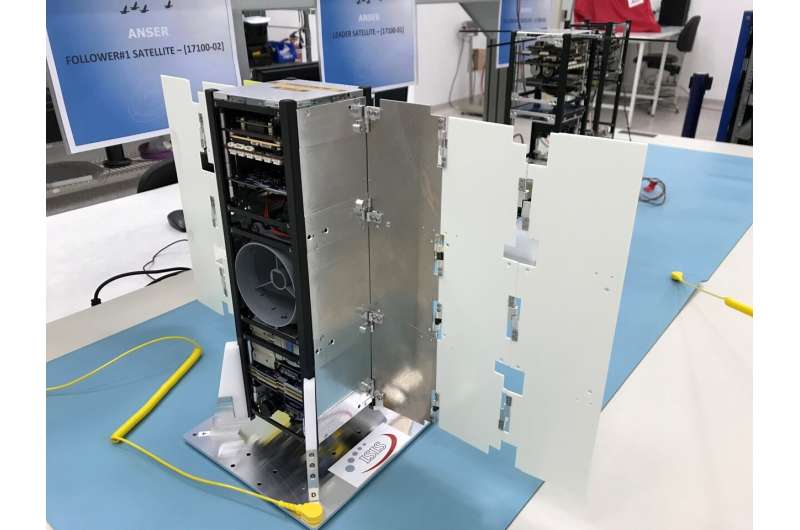This article has been reviewed according to Science X's editorial process and policies. Editors have highlighted the following attributes while ensuring the content's credibility:
fact-checked
trusted source
proofread
Vega's fuel-free CubeSats will use wings to keep in formation

Spain's trio of ANSER CubeSats, due to fly on Europe's next Vega launcher, will fly like a flock of birds in orbit—in more ways than one. Keeping in formation by following their leader, the three shoebox-sized satellite will image Iberian waters as if they are a single standard-sized mission. And they will unfurl wing-like flaps to maintain their relative positions, surfing on the scanty airflow at the top of Earth's atmosphere.
ANSER—Advanced Nanosatellite Systems for Earth-observation Research—is a cluster of three CubeSats which will work together in close vicinity as if they are a single satellite. Due to be launched on Europe's next Vega flight, VV23, the ANSER mission is being undertaken by INTA, the Spanish Institute of Aerospace Technology.
Santiago Rodriguez Bustabad, overseeing the mission, explains, "ANSER is also the Latin name for the wild goose, a good example of birds flying in formation, adopting a leader-follower protocol, which is what our mission is emulating."
These three-unit CubeSats will orbit around 500 km altitude, maintaining formation at an optimum 10 km apart from each other. But they do not have any onboard propulsion systems. Instead they control their relative positions by deploying a set of flaps against the trace amounts of air at the top of the atmosphere. These will multiply their wingspan sixfold, allowing them to either drag themselves downward or lift themselves upward and sideways.
He adds, "A specially-developed algorithm will be used to plan these 'Differential Lift and Drag' maneuvers on the ground for telecommand uplink to the satellites. Increasing the drag effect allows the creation of significant relative movements along track, while the more lightweight lift effect can produce small cross-track shifts.
"The precise aerodynamic resistance is highly dependent on the orbital altitude, but on average we would expect to spend no more than 72 hours to produce 10 km of along-track separation. Later in the mission we might attempt autonomous onboard maneuvering as well."
One of the CubeSats serves as a leader, undertaking communications with the ground and connected to the others via inter-satellite links. It will also lead joint observations of ANSER's main target, the quality of inland Iberian lakes and reservoirs, as well as comparable water bodies worldwide.
Santiago continues, "ANSER's hyperspectral imager CINCLUS—named for another bird species—is a fractionated payload distributed across the three CubeSats. The leader satellite has a panchromatic cameras to detect clouds and pre-validate the utility of the hyperspectral images before processing on the ground. The two follower satellites host miniaturized hyperspectral cameras incorporating micro-spectrometers."
These four spectrometers cover the visible to near infrared region, supported by the panchromatic camera, delivering 60 m spatial resolution, offering insight into the suspended contents of water bodies, including its pollution levels or the presence of toxic microorganisms such as harmful phytoplankton blooms.
Santiago notes, "In recent years CubeSats and nanosatellites under 10 kg of mass have transformed from educational tools into highly-valued spacecraft for many commercial and government sectors, favored for their short development times, rapid assimilation of new components and miniaturized sensors, lower costs—including launch costs—and improved functionality.
"But achieving operational performance can still be a challenge for such small satellites because of their limitations in terms of available power, ground coverage and resolution, revisit times and so on. And the use of commercial-off-the-shelf components and non-space-qualified parts adds extra risk.
"So to have a real chance of achieving an operational Earth-observing mission we are leaning into distributed systems in the form of clusters and constellations, together with miniaturization."
Without onboard propulsion, the operational lifespan of an ANSER cluster will be limited to two or three years, depending on their initial altitude. But the fractionated platform approach means this is more of a strength than a weakness because replacement CubeSats can be added to the cluster regularly, offering the chance to perform hardware upgrades in orbit.
Santiago explains, "In time the individual CubeSats would all be deorbited, but replaced in the meantime by more up-to-date versions, so that their overall mission could continue uninterrupted."
ANSER is due to fly on Vega's Small Spacecraft Mission Service, a rideshare service for small satellites, securing its place through the European Commission's In-Orbit Demonstration/In-Orbit Validation program.
Managed on behalf of the Commission by ESA's Small Satellite Platform Unit, this program allows the early orbital testing of new technologies to make Europe's space sector more competitive.
Santiago comments, "ANSER has been developed using INTA's internal funding, but one of the most important strengths supporting our project over the past four years of work has been its selection for flight—after open competition with other European proposals—through the IOD/IOV Program. With this support, ANSER could overcome various difficulties, including financial issues and the impact of the COVID pandemic, without losing sight of its main goal of in-orbit demonstration."
Vega flight VV23 is due for lift-off next week from Europe's Spaceport in French Guiana. Along with its main satellite payloads it carries multiple CubeSats including ESA's PRETTY mission investigating reflected satnav for environmental monitoring, the Proba-V Companion CubeSat testing the performance of a previously flown spectral imager aboard a CubeSat and other IOD/IOV CubeSats.
Provided by European Space Agency





















